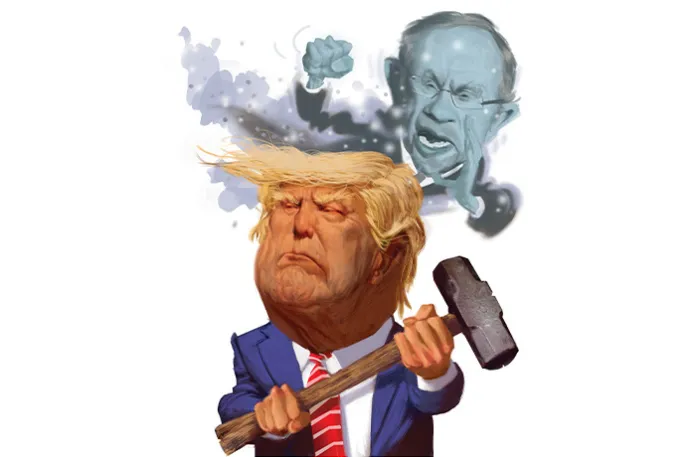The federal government has been shut down for over a month, and political finger-pointing has persisted since it began. Republicans claim that they have passed clean continuing resolutions that get blocked in the Senate, while Democrats argue that Republicans and President Donald Trump are refusing to negotiate, particularly over the issue of expanded Obamacare subsidies. Poll results are mixed, but this year’s election results were bad for Republicans. As the shutdown drags on and the holiday season nears, frustrations are growing. Trump, with his characteristic impatience, has turned that frustration into a rallying cry. His solution? “Get rid of the Filibuster, and get rid of it, NOW!”
Trump has long viewed the Senate’s 60-vote requirement as an obstacle to decisive action and a measure of his power over the GOP. He called for its elimination during his first term, attempting to bully then-Senate Majority Leader Mitch McConnell (R-KY) into doing so when key parts of Trump’s agenda stalled, and McConnell refused. Now, as the shutdown drags on and his legislative priorities remain stalled, he’s repeating that demand. The morning after Democrats swept the biggest races in the Nov. 4 elections, Trump summoned Republican senators to the White House so he could lobby them on the matter.
To Trump, the filibuster is not a safeguard of deliberation. It is a guardrail he wants to plow through with little consideration for the implications beyond his presidency. However, eliminating it would not end the dysfunction in Washington. It would guarantee chaos and, in time, deliver Democrats legislative victories they’ve long sought.

The filibuster is not written into the Constitution, yet it has defined the Senate for more than a century. The rule requires 60 votes to close debate on most legislation before proceeding to a final vote. Supporters say it forces consensus, prevents one-party dominance, and protects minority rights. Critics say it is a tool designed to stall “democracy,” using phrases such as the “tyranny of the minority” to illustrate how it prevents legislation from passing.
That frustration is by design, however. It slows rash policymaking and makes it difficult for slim majorities to impose sweeping changes that half the country rejects. Eliminating it would turn the Senate into a miniaturized version of the House, where bills can pass with a simple majority and little debate. James Madison warned against this, with the Senate being a “necessary fence” or a check against what he called the “fickleness and passion” of the House.
Trump’s latest demand to kill the filibuster comes at a politically risky moment. His poll numbers have slipped since the shutdown began. Despite states’ moves to create new districts designed to maintain Republican control in the House, Democrats could still win — and if so, any legislation the president wants passed will die on the vine. Still, some Republican senators, notably Sens. Bernie Moreno (R-OH) and Josh Hawley (R-MO), have echoed Trump’s call. Sens. Tommy Tuberville (R-AL) and Rick Scott (R-FL) say it should be an option, though they haven’t taken the leap to fully support the move.
There is also a personal aspect. Trump sees the filibuster as a symbol of defiance within his own ranks. Senate Majority Leader John Thune (R-SD) has explicitly said he will not do it. House Speaker Mike Johnson (R-LA), who rarely breaks with Trump in public, acknowledged that he has no role in making a decision on the filibuster, but he warned of its implications. Eliminating the filibuster now would show that, this time, when Trump says, “Jump,” Republicans ask, “How high?” It is not only about policy but about control and proof that his party does what he tells it to do.
Democrats are not immune to such moves. In 2022, then-President Joe Biden wanted to eliminate the legislative filibuster on several occasions. Naturally, Biden and Democrats who supported the move tried to temper the criticism by insisting they were calling for mere “carve-outs” for particular legislation. In one instance, it was “voting rights” legislation, which was much more about federalizing local elections and overriding state laws.

Following the Supreme Court’s decision overturning Roe v. Wade, Biden called for eliminating the filibuster again to pass abortion legislation. Biden, agreeing with former President Barack Obama that the rule was “a relic of the Jim Crow era,” attempted to frame it as inherently racist, the go-to rhetorical weapon meant to shame opponents rather than engage the constitutional principle of checks and balances. Democrats joined in the criticism, despite having used the filibuster multiple times during Trump’s first term to block legislation he wanted to sign.
Surprisingly, it was two Democrats who ensured the rules would not change: Joe Manchin of West Virginia and Kyrsten Sinema of Arizona refused to go along. Both argued that weakening the filibuster would weaken the Senate itself. “Allowing one party to exert complete control in the Senate with only a simple majority will only pour fuel on the fire of political whiplash and dysfunction that is tearing this nation apart,” Manchin said. The irony is that neither remains in the chamber today. Manchin retired, and Sinema, facing primary threats, declared herself an independent and chose not to run for reelection.
McConnell tried to warn his colleagues in March 2021, when Democrats were toying with the idea of ending the filibuster. He stood on the Senate floor and, during a speech, described exactly what would happen if the 60-vote threshold disappeared, Republicans regained control of the Senate, and a Republican president were in office.
“How about this?” McConnell said. “Nationwide right to work for working Americans. Defunding Planned Parenthood and sanctuary cities on Day One. A whole new era of domestic energy production. Sweeping new protections for conscience and the right to life of the unborn. Concealed carry reciprocity in all 50 states and the District of Columbia. Massive hardening of security on our southern border.”
His point was not that those policies were wrong. It was that once one party breaks the rule, the other will use that same power to its own ends. As McConnell said, short-term victories often carry long-term costs. In 2013, then-Senate Majority Leader Harry Reid’s (D-NV) decision to eliminate the filibuster for lower-court and executive-branch nominations gave Democrats a fleeting win. When they changed the rules, they celebrated. Four years later, Republicans used the precedent to confirm Neil Gorsuch, Brett Kavanaugh, and Amy Coney Barrett to the Supreme Court. Each side believes it can outmaneuver the other, and each time, the consequences come faster.
If Republicans follow Trump’s lead and eliminate the filibuster, they will discover that lesson the hard way. A future Democratic majority with a Democrat in the Oval Office would not hesitate to pass a national abortion law codifying Roe v. Wade; expand the Supreme Court or term-limit justices; federalize election rules; push through trillions in more “green energy” spending; give statehood to Washington, D.C., and Puerto Rico; raise corporate and individual taxes, including implementing a “wealth tax;” pass restrictive new gun legislation; and enact union-friendly labor laws such as the PRO Act. All of it could become law with a single-vote majority and a willing president.
Democrats have already justified that outcome in moral terms. They have called the filibuster racist, undemocratic, and illegitimate. They are waiting for Republicans to give them permission to end it by doing it first. Once that line is crossed, there is no going back. Among populists in government, the idea of killing the filibuster fits neatly into a broader narrative of action over process. Both sides see it as “fighting back” against the other party and accuse each other of playing by no rules.
The shutdown is a reminder that Washington’s problems are not procedural — they are political. The filibuster did not cause the impasse over spending, immigration, or healthcare. It is a symptom of a deeper polarization that rules changes cannot fix. Stripping away the 60-vote rule will not make Congress work better. It will merely make it easier for each new majority to undo, or try to undo, whatever the last one passed, guaranteeing perpetual upheaval.
For Trump, however, the filibuster fight is personal. It represents unfinished business from his first term, when Senate Republicans defied him and refused to change the rule. Ending it now would show that he commands total loyalty, with the demand being as much about power as policy — a test of who runs the party: its institutions or its leader. That quest for control mirrors his broader political approach. Whether dealing with foreign allies, state governments, or his own Cabinet, Trump has always equated agreement with loyalty and resistance with betrayal. The filibuster is one of the few remaining places where resistance still exists. That may be why he wants it gone as much as he wants any legislative victory.
TRUMP IN NO RUSH TO END SHUTDOWN IMPASSE
The filibuster frustrates presidents, party leaders, and activists alike. It forces negotiation in a system increasingly allergic to compromise. But that friction is what prevents the Senate from becoming just another partisan battlefield. Abolishing it would not restore order — it would destroy what little remains, wreaking havoc within Washington, the courts, and the states. The filibuster was created to slow things down for a reason. By removing it, the rhetoric of “the most important election of our lifetime” would become that much more common as a rallying cry to reverse the last result.
Trump may see the filibuster as a wall in his way. In truth, it is the last wall standing between the country and chaos.
Jay Caruso is a writer living in West Virginia.
